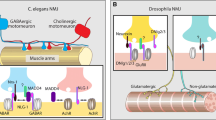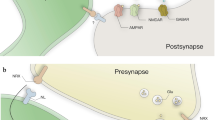Abstract.
Proper brain connectivity and neuronal transmission rely on the accurate assembly of neurotransmitter receptors, cell adhesion molecules and several other scaffolding and signaling proteins at synapses. Several new exciting findings point to an important role for the neuroligin family of adhesion molecules in synapse development and function. In this review, we summarize current knowledge of the structure of neuroligins and neurexins, their potential binding partners at the synapse. We also discuss their potential involvement in several aspects of synapse development, including induction, specificity and stabilization. The implication of neuroligins in cognitive disorders such as autism and mental retardation is also discussed.
Similar content being viewed by others
Author information
Authors and Affiliations
Corresponding author
Additional information
Received 6 February 2006; received after revision 17 March 2006; accepted 26 April 2006
Rights and permissions
About this article
Cite this article
Lisé, MF., El-Husseini, A. The neuroligin and neurexin families: from structure to function at the synapse. Cell. Mol. Life Sci. 63, 1833–1849 (2006). https://doi.org/10.1007/s00018-006-6061-3
Published:
Issue Date:
DOI: https://doi.org/10.1007/s00018-006-6061-3




